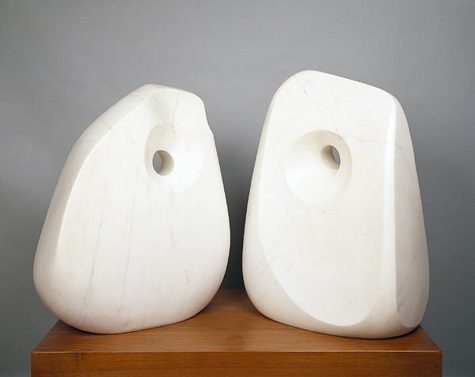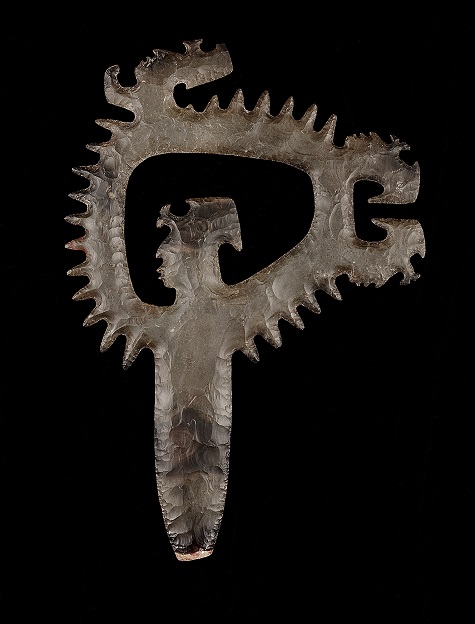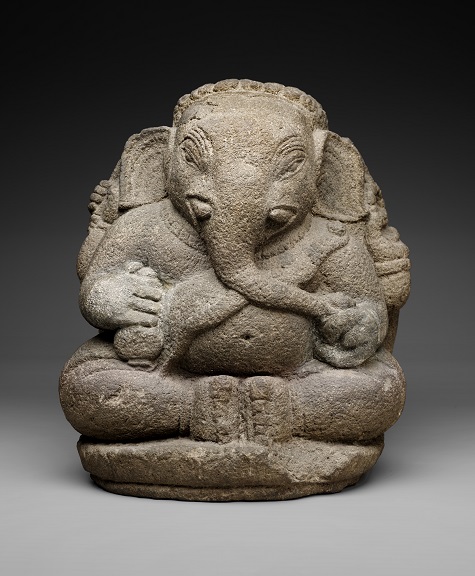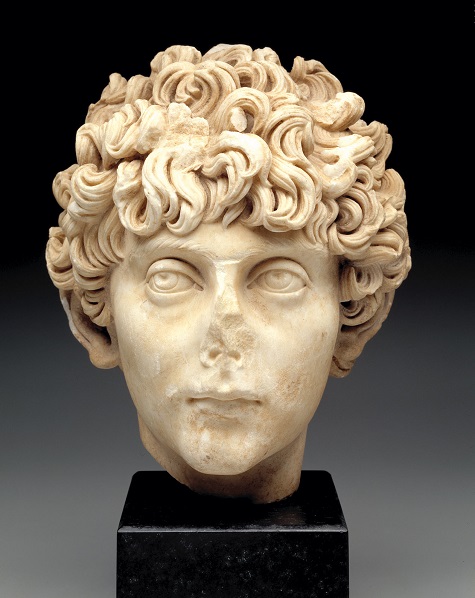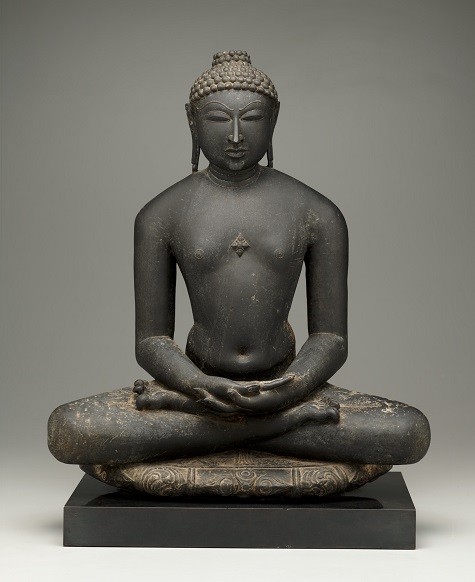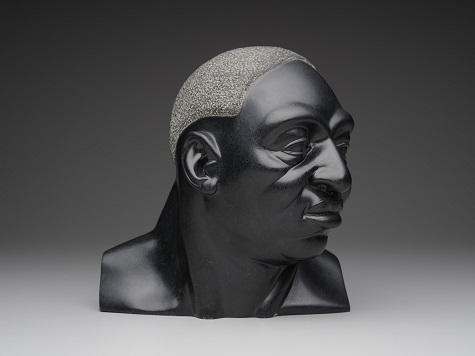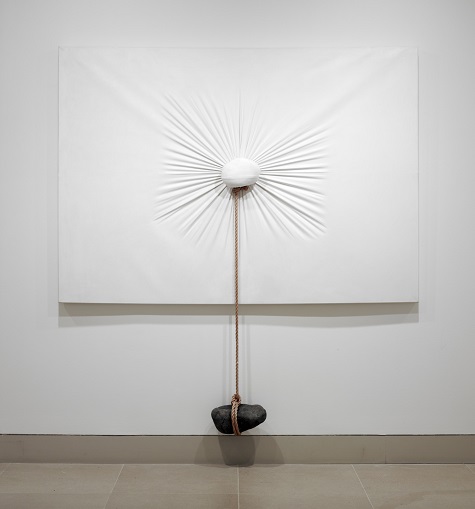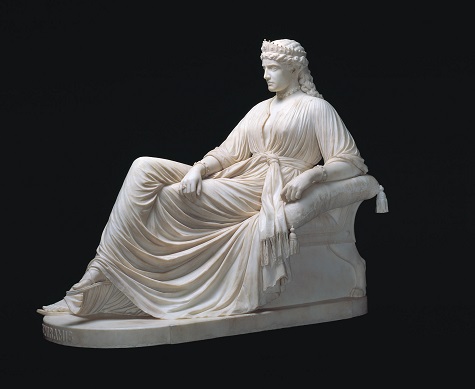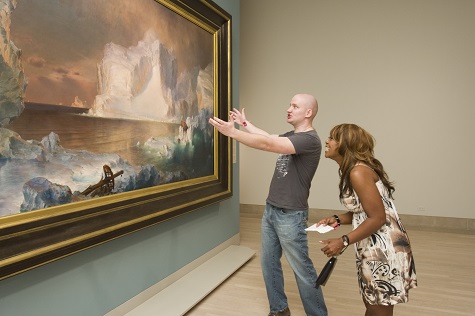Isa Genzken: Retrospective, currently on view in the DMA’s Barrel Vault, arrived in Dallas after presentations in New York and Chicago, and came together after weeks of installation. Each work of art required a different approach and took varying amounts of time to place on display. Below, watch the installation process of Genzken’s 2007 work Oil XI, which invites you into the exhibition. Visit it now for free through January 4, 2015.
Archive Page 24
Lost in Space
Published October 20, 2014 Exhibitions ClosedTags: Dallas Museum of Art, DMA, Isa Genzken, Isa Genzken: Retrospective
Why Flowers?
Published October 15, 2014 Collections , Conservation , DMA Partners , Exhibitions ClosedTags: Anne Vallayer-Coster, Bouquets, Bouquets: French Still-Life Painting from Chardin to Matisse, Chagall: Beyond Color, Dallas Museum of Art, DMA, Edouard Manet, Floral Still Life, flowers, Gustave Caillebotte, Henri de Toulouse-Lautrec’, Henri Fantin-Latour, Henri Matisse, J. M. W. Turner, Mind’s Eye: Masterworks on Paper from David to Cézanne, Odilon Redon, Paul Bonnard, Virginia Museum of Fine Arts

The Dallas Museum of Art is currently at T-minus 11 days until the opening of our new exhibition, Bouquets: French Still-Life Painting from Chardin to Matisse. Floral still-life paintings are arriving from across North America and Europe, and Bouquets will open to the public on Sunday, October 26, 2014 (DMA Partners will have a chance to see the exhibition a few days earlier during the DMA Partner Preview days on October 23-25).
As a curator of this exhibition, I’ve already had several people ask me how I became interested in this rather specialized subject. I will confess straightaway that it is not because I have any particular skill in growing flowers (sadly, the contrary), identifying flowers (I have a shockingly bad memory for names, of both plants and people), or arranging flowers (even the most elegant bouquet from the florist becomes an awkward muddle when I’m entrusted with the task of transferring it to a vase). So, I did not enter into this exhibition with the belief that I had any special insights into the world of flowers to share.
Rather, I was brought to the exhibition by the DMA’s art collection. In some cases, we decide to pursue an exhibition because it allows us as curators to share with our audiences art that is not represented in depth in our own collection. This was the case with J.M.W. Turner in 2008 or Chagall: Beyond Color in 2013; however, there are also moments when we create exhibition projects as a way to showcase particular strengths of our collection and build a major research project around our own masterpieces. This was the case with Bouquets.
Several years ago, I was approached by my co-curator, Dr. Mitchell Merling of the Virginia Museum of Fine Arts, with an idea for an exhibition of French floral still-life painting. He wanted the exhibition to focus on the table-top still life and the bouquet, and was starting to build a list of possible works to include. Did the DMA have many paintings that fit that description, he asked? By the time I finished rounding up all the works that fit the bill, I went back to Mitchell and told him that I hoped to partner with him in curating the exhibition. Not only did the DMA have more than a dozen works of art that met the criteria, but quite a number of them were also masterpieces of our European art collections. These included important (and incredibly beautiful) paintings by Anne Vallayer-Coster, Henri Fantin-Latour, Edouard Manet, Gustave Caillebotte, Paul Bonnard, and Henri Matisse. I knew that this exhibition would be an invaluable opportunity to give these paintings the kind of visual and scholarly context they so richly deserved. Luckily, Mitchell agreed with me, and we set to work on crafting the exhibition together.
Bouquets includes six important paintings from our collection, making the DMA the largest single lender to the exhibition. In addition to these works that will travel with the exhibition to the Virginia Museum of Fine Arts in Richmond and the Denver Art Museum in 2015, we have also included two additional still lifes from our collection just for the show’s presentation in Dallas—the more the merrier! Although there wasn’t room to include all of our French floral still-life paintings in the exhibition, you can see several others elsewhere in the Museum.
For instance, in Mind’s Eye: Masterworks on Paper from David to Cézanne (on view until October 26, 2014, the same day that Bouquets opens), you can see a major pastel, Flowers in a Black Vase, by the inventive symbolist artist Odilon Redon. Redon is featured in Bouquets with three paintings, but because of the length of the exhibition tour we were not able to include any of his ethereal and fragile pastels. In Flowers in a Black Vase, Redon crafts one of his most sumptuous and darkly beautiful bouquets, a perfect floral tribute for the Halloween season:
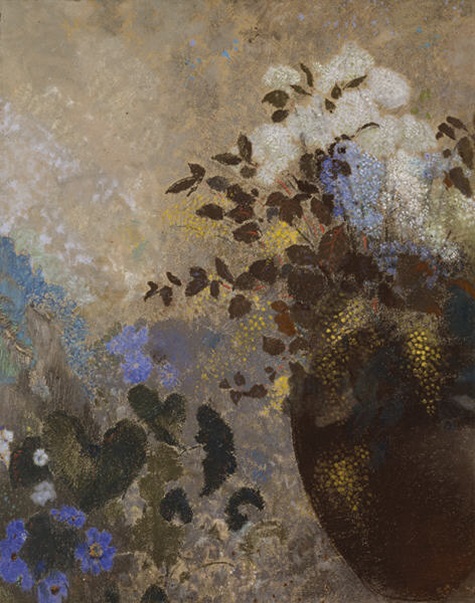
Odilon Redon, Flowers in a Black Vase, c. 1909-10, pastel, Dallas Museum of Art, The Wendy and Emery Reves Collection
When you visit our galleries of European art, you’ll see that in the place of Fantin-Latour’s Still Life with Vase of Hawthorne, Bowl of Cherries, Japanese Bowl, and Cup and Saucer, featured in Bouquets, we’ve brought out another painting, Flowers and Grapes, by the same artist. This meticulously composed autumn still life was one of the first paintings in the collection selected for treatment by Mark Leonard, the DMA’s new Chief Conservator, even before his Conservation Studio was opened last fall. The jewel-like tones of the chrysanthemums, zinnias, and grapes in the newly cleaned painting now positively glow on our gallery walls.
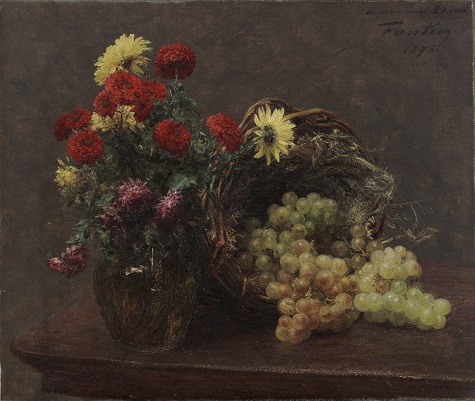
Henri Théodore Fantin-Latour, Flowers and Grapes, 1875, oil on canvas, Dallas Museum of Art, gift of the Meadows Foundation, Incorporated
And, finally, in the Wendy and Emery Reves Galleries on Level 3, be sure not to miss a special display of one of our smallest and most unpretentious bouquets, Henri de Toulouse-Lautrec’s Bouquet of Violets in a Vase. Painted when the artist was just 18 years old, this still-life reveals the potent influence of Manet on the young artist, as well as Lautrec’s own precocious talent. This small panel painting, usually displayed in the Library Gallery of the Reves wing, where it is difficult for visitors to appreciate, is currently on view in an adjacent space where it can be enjoyed up-close, alongside another early painting by Lautrec.
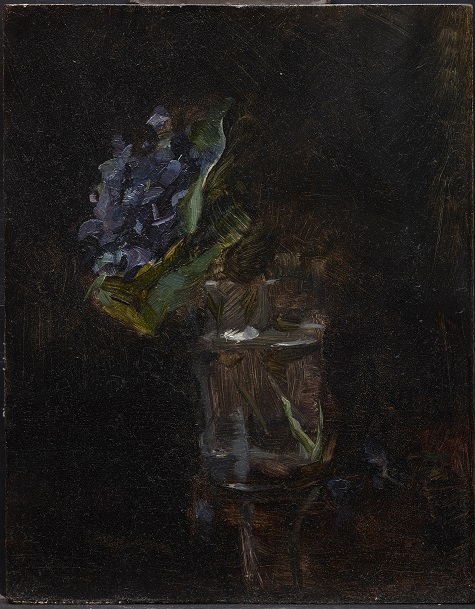
Henri de Toulouse-Lautrec, Bouquet of Violets in a Vase, 1882, oil on panel, Dallas Museum of Art, The Wendy and Emery Reves Collection
Flowers are in bloom throughout the Museum this October, and there is no better time to fully appreciate the depth, importance, and sheer beauty of the DMA’s collection of European still-life painting.
Heather MacDonald is The Lillian and James H. Clark Associate Curator of European Art at the DMA.
Mind’s Eye from a Different Frame of Reference
Published October 8, 2014 Behind-the-Scenes , Collections , Exhibitions ClosedTags: Dallas Museum of Art, DMA, Edgar Degas, Ernest Biéler, frames, Mind's Eye, Pablo Picasso, Pascal Dagnan-Bouveret, Théodule Ribot
You still have time to come to the Dallas Museum of Art to visit the exhibition Mind’s Eye: Masterworks on Paper from David to Cézanne before it closes on October 26. The show is a rare opportunity to see exceptional drawings, pastels, and watercolors by many of the most acclaimed European artists in the Museum’s collection, as well as some from many local private collections. Linger in a gallery and closely study exquisite works by Renoir, Gérôme, Pissarro, Bonnard, and Mondrian. Then, before moving into the next room, step back a bit to view the broad array of frames that surround these fabulous artworks. The various shapes, designs, and colors add a pleasant texture to the walls and bring an unmatched intimacy to the overall experience.
Consider the fantastic tabernacle frame surrounding Pascal Dagnan-Bouveret’s little gem Portrait of Gustave Courtois. With its liner plinth (or base), columns topped with Corinthian capitals, and crowning entablature, it’s easy to see that this sort of frame employs a structure and ornamentation inspired by ancient Greek and Roman architecture. The intricate gold ornamental foliage patterns coursing over the narrow, flat groves of dark green couple with rich gilding to elevate the mystery of the distinguished sitter, who was a fellow artist.

Nearby is Théodule Ribot’s Head of an Old Man with Beard and Cap. This little drawing from the DMA’s collection was in storage unframed, but we did not need to go any further than our own Reves Collection to find something perfect. Based on 17th-century Dutch frames with waffle or ripple style moldings that were darkly painted to simulate ebony, this frame is enhanced throughout by long passages of inlaid tortoise shell. Then, to bring perfect harmony to drawing and frame, we added a custom-designed mat embellished with strands of pale blue, silver, and brown marbling that echoes the frame’s tortoiseshell.

Like museums, artists were often quite particular about their frames. For example, Edgar Degas most likely designed the frame on his drawing After the Bath, Woman Drying Herself. This frame has the hallmarks of his most inventive design, which includes a soft overall gilding over a lightly rounded profile, enhanced with rows of thin parallel grooves. Degas called this frame a “cockscomb” or “cushion” pattern. The frames’ characteristic gentle curves subtly reinforce the arc in the nude’s back, as well as the fleshiness of her torso, buttocks, and arms.
Even simpler than Degas’s frame is the one that Swiss artist Ernest Biéler designed for his L’épine-vinette. He polished the wood (oak) to bring out its subtle grain, allowing it to serve as a backdrop to the small strips of wood that step down at the sight edge, drawing our eyes toward the lovely portrait. Biéler followed a similar design scheme when made the frame for his Self-Portrait, which hangs to the left. Thus we see both of these works just as he intended.

In the last room of the exhibition, you will find a fantastic frame on Pablo Picasso’s Still Life with Glass and Bowl. Although probably not designed by Picasso, its strong linear features and curvilinear gold leaf embellishments mirror those same aspects in the master’s drawing.
If you are not ready to explore the rest of the Museum, return to the first Mind’s Eye gallery for a look at the one-of-a-kind mat surrounding Hubert Robert’s View of the Gardens at the Villa Mattei. The cartouche bearing the artist’s name is a work of art itself.
Martha MacLeod is the Curatorial Administrative Assistant for the European and American Art Department at the DMA.
Yesterday was World Teacher’s Day so we thought we would celebrate a few artists and their mentors in the DMA’s collection.

(left to right) Eugène-Louis Boudin, The Quay at Antwerp, 1874, oil on panel, Dallas Museum of Art, gift of the Meadows Foundation, Incorporated; Claude Monet, Water Lilies, 1908, oil on canvas, Dallas Museum of Art, gift of the Meadows Foundation, Incorporated
Artist Eugène-Louis Boudin played an important role in influencing Claude Monet’s work in the mid-1800s, directing Monet to landscape paintings. Visit work by Boudin and Monet in the DMA’s European Galleries on Level 2.

(left to right) Antoine-Louis Barye, Turkish Horse, c. 1838, bronze, Dallas Museum of Art, Foundation for the Arts Collection, Mrs. John B. O’Hara Fund; Auguste Rodin, The Sirens, c. 1888, marble, Dallas Museum of Art, The Wendy and Emery Reves Collection
Auguste Rodin considered Antoine-Louis Barye an important figure in his life and said that he had learned the most from this artist than from any other. View a sculpture by Barye in the Mind’s Eye: Masterworks on Paper from David to Cézanne exhibition before visiting a few of Rodin’s works in the Museum’s Wendy and Emery Reves Collection on Level 3.
Discover a number of artist connections in the current The Museum Is History exhibition, which is included in the DMA’s free general admission. Find out more about the artists and their influence on each other, including Frank Stella’s influence on Louis Morris, from DMA curator Gavin Delahunty on the DMA’s program recordings page.
Fall Transition
Published September 24, 2014 African Art , Center for Creative Connections ClosedTags: African Art, C3, Cameroon, Dallas Museum of Art, DMA, Isa Genzken, Kom people, Lesli Robertson, Natalie Macellaio, the Center for Creative Connections

Transition in the Center for Creative Connections is always a bittersweet time. While we’re excited by the infusion of new art in our gallery because it brings new experiences for our visitors, this week we had to say good-bye to some favorites: The Visitors by Jacob Lawrence, Frank Smith watering his horse, Cross-B Ranch, Crosby County, Texas by Erwin Smith, and Soul Three by Romare Bearden. Now we’re welcoming Ram Mask with Feather Cape by the Kom people in Cameroon, two films by Isa Genzken, and The Mother Load Project, an interactive installation by local artists Lesli Robertson and Natalie Macellaio. Here’s a little more about our newest installations:

Helmet mask with feather costume, Cameroon, North West Province, Kom peoples, early to mid-20th century, wood, fibers, and feathers, Dallas Museum of Art, African Collection Fund
This mask depicts a ram, an animal that is sacrificed in religious rituals. While the face of the animal is carved naturalistically, the horns are designed as two stylized spherical knobs composed of concentric rings. When the mask is worn, it fits snugly on top of the dancer’s head and the dancer’s face is concealed under a fitted hood. The dancer also wears a costume of chicken feathers.  While we are interested in visitors being able to explore the sensory elements of this piece, including the texture of the materials, the weight of the mask, the sounds of a masquerade, and the sight of the feathers in motion, this month we will focus activities in the C3 on mask making. If you were to create a mask symbolic of yourself or an event in your life, what animal would you choose as a symbol, and why?
While we are interested in visitors being able to explore the sensory elements of this piece, including the texture of the materials, the weight of the mask, the sounds of a masquerade, and the sight of the feathers in motion, this month we will focus activities in the C3 on mask making. If you were to create a mask symbolic of yourself or an event in your life, what animal would you choose as a symbol, and why?
Additional works from our African collection have recently been installed in the African Galleries on Level 3, including the new acquisition of a sword ornament in the form of a spider.

In conjunction with the current exhibition Isa Genzken: Retrospective, on view through January 4, 2015, the Center for Creative Connections is showing two films by Genzken in the C3 Theater. On weekdays you can see Chicago Drive, a 16mm film made in 1992 while Genzken was in Chicago preparing for her Renaissance Society exhibition. It reveals her fascination with local architecture, both the famous and the mundane, and also includes intermittent blues music on the soundtrack. On the weekends, My Grandparents in the Bavarian Forest will be on view. This 63-minute film has English subtitles and is a personal account of Genzken’s grandparents’ home in southern Germany. Through the recording of seemingly banal conversations and her grandparents’ quotidian rituals, Genzken draws a moving portrait of the complexity of family dynamics, and the difficulty of coming to terms with the survivors of the World War II generation.

This week artists Lesli Robertson and Natalie Macellaio have been on hand in the Center for Creative Connections installing The Mother Load project, an interactive work that hopes to start a dialogue with visitors about the balance of nurturing in one’s life. The collaborative project began as a way to engage with women who lead the creative life of an artist while also being a mother. Through the project, Robertson and Macellaio are collecting fingerprints from artists and their children, recording experiences through written word and audio interviews, and documenting the ongoing project through their interactive website (themotherload.org). In the interactive component of the installation, visitors are asked to respond to this question: “In your life right now, what are you nurturing, and why?” Look for an upcoming post where we interview Robertson and Macellaio about The Mother Load.
Jessica Fuentes is the C3 Gallery Coordinator at the DMA.
Most Likely to Succeed
Published September 22, 2014 Staff ClosedTags: Dallas Museum of Art, DMA, McDermott Internship, McDermott Internship program
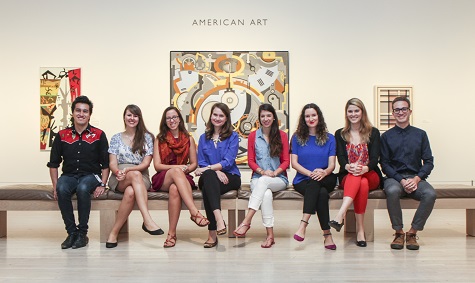
Left to right: Fabian Leyva-Barragan, Jennifer Sheppard, Taylor Jeromos, Laura Sevelis, Liz Bola, Elisabeth Seyerl, Samantha Robinson, Eliel Jones
September doesn’t usually mean cooler weather in Texas, but here at the Museum it does mean we get to welcome some cool new faces—our McDermott Interns!
This year’s class is full of enthusiasm, which you can surely see as they posed in our American Galleries. They each bring their own distinct backgrounds, which include:
Fabian has Protanopia, which means that he is color blind—a fact he did not learn until college.
Jennifer is working on learning French, her fourth language in addition to English, Spanish, and Hebrew.
Taylor was the lead in a production of Annie while in the 5th grade in Ohio.
Laura taxidermied animals while working at the University of Wisconsin Zoological Museum.
Liz fell out of a window when she was 7 years old, but walked away unscathed.
Elisabeth studied Royal Javanese Dance at a royal palace in Java, Indonesia.
Samantha studied Nahuatl, a language spoken in central Mexico by those of Aztec descent.
Eliel spent the past summer working at a salmon fishery on a remote arctic fjord in northern Norway.
We look forward to working with this exciting bunch in the months ahead!
P.S. If you’re interested in becoming a McDermott Intern next year, check the DMA website in late January 2015 for details on how to apply!
Sarah Coffey is the Education Coordinator and former McDermott Education Intern for Adult Programming at the DMA.
Cold Case Closed
Published September 12, 2014 American Art , Collections , Curatorial ClosedTags: BBC, Canadian coast, Captain Sir John Franklin, Dallas Museum of Art, DMA, Frederic Church, Lady Franklin., Northwest Passage, The Icebergs

Prime Minister Stephen Harper (right) of Canada listens as Parks Canada’s Ryan Harris talks about an image showing one of two ships from the lost Franklin expedition, in Ottawa. Photo: Reuters. Website: http://www.smh.com.au/.
In news disclosed this week, history came to life and reached out to touch Frederic Edwin Church’s masterful painting The Icebergs (1861) in the DMA’s collection. The recent discovery of one of two ships submerged in the arctic waters off the Canadian coast also brings to closure one of the great mysteries of expeditionary navigation. In the trip led by Captain Sir John Franklin, two ships sailed in 1845 in a failed attempt to map and navigate the Northwest Passage. The captain and his men perished in the cold conditions. In 1863 Frederic Church would tap into this tragic tale in an attempt to make The Icebergs more appealing to British collectors. Before shipping the work to England, he added the broken mast of a ship in the foreground as a direct allusion to the doomed expedition. The opening for the painting’s exhibition in London was attended by many Arctic explorers, as well as the widowed Lady Franklin.
Learn more about the discovery of one of Franklin’s ships, including video of the discovered ship, on BBC.com.
Sue Canterbury is The Pauline Gill Sullivan Associate Curator of American Art at the DMA.
State of the Arts: Contemporary Artists
Published September 10, 2014 Arts District , Dallas , DFW , Education , Guest Blog Post ClosedTags: Arthur Peña, Contemporary Art, Dallas Museum of Art, Darryl Ratcliff, Devon Nowlin, DMA, Homecoming Committee, KERA Art&Seek, Modern Art Museum of Fort Worth, National Center for Arts Research & Initiative on Arts+Urbanism, State of the Arts, VICE PALACE, WARE:WOLF:HAUS
We’re kicking off our fall season with our first State of the Arts program, our collaboration with Art&Seek and KERA. Join us Thursday night at 7:00 p.m. for a discussion with three DFW artists: Devon Nowlin, Arthur Peña, and Darryl Ratcliff.

Uncrated was able to ask them a few questions beforehand:
1. What is the most appealing aspect of being a working artist in Dallas?
Devon Nowlin (artist; founding member, Homecoming Committee): As an artist who also works full-time, I have had good employment opportunities in my field and see some good job prospects for artists in both Dallas and Fort Worth. Along with exhibitions, teaching opportunities, and other work-work, one can construct a patchwork of professional activities for one’s self here.
Arthur Peña (artist; founder and Director, WARE:WOLF:HAUS and VICE PALACE): The two very prominent aspects I can think of are pragmatic ones. First, it is extremely affordable to be a working artist in Dallas. It’s not unheard of to have an apartment and a studio for under $600. I don’t know what other major cities can offer that and also boast world-class museums and an established art scene. Second, the accessibility to the Dallas art world is shockingly overlooked. If one wanted, they could meet and shake hands with other artists, gallery directors, collectors, and museum directors at one gathering. And they would be cordial and welcoming. Try that in NYC and see what happens!
Darryl Ratcliff (artist; Community Engagement Associate, National Center for Arts Research & Initiative on Arts+Urbanism): Affordability and opportunity. The access one has to cheap space is truly unique in Dallas, and the general cost of living is far cheaper than in other major cities. Also, there is significant upward mobility in the art scene. There is a willingness to experiment and embrace new ideas and artists.
2. What is something you are thankful for in your art community/peers/scene and how it/they have contributed to your practice?
DN: I am very thankful for the Education Department of the Modern Art Museum of Fort Worth. I have benefited greatly from their programs both as a participant and audience member over the years, and as an artist-instructor in their programs. They give professional, and yet experimental and creative, teaching opportunities to artists in the area, and I have cherished my experiences there. So that is one of the many things in my community that I am very thankful for.
AP: Quick story: The recently retired WARE:WOLF:HAUS operated on limited funds for every show and especially the last fall season. Because of its location, security was needed on top of insurance for liability purposes. Not once did I pay out of pocket for any of that. WWH was able to operate and host shows strictly through donations from my fellow artists and supporters. People would toss whatever they had into the donation bucket, or specific people in the art community donated large funds to keep the door open and allow shows to happen. Considering that WWH was not a nonprofit art space and people were throwing down hard cash, I find this willingness to support the artists and work as a truly collaborative effort inspiring.
DR: It is cliché but I am very thankful for my fellow creatives in this city. My work is collaborative by nature, so I couldn’t have had any success without the constant support and cooperation of literally hundreds of creatives and lovers of creativity over the last five years.
3. How would you improve the Dallas art community/scene ?
DN: In Fort Worth, we are also in need of the facilities and funding that Darryl would like to bring to Dallas. What we don’t have that would really help elevate the local Forth Worth scene is more critical attention in both print and online publications. If artists here could get some press, I think it could help push the dialogue in Fort Worth in ways that I see happening in Dallas. I am encouraged by a level of interaction that is happening among artists between Dallas and Fort Worth, though it tends to be a one-way street with artists going from Fort Worth to Dallas. I’d like to see us mix things up a little more!
AP: Besides the obvious need for an influx of funds either through more grants or private donors, I’m not sure how one could improve the community other than more involvement from the community at large. There needs to be a cultural and psychic shift here in Dallas, and Texas as a whole, when it comes to the arts. Without a steady stream of interest starting at the city’s top level, the city at large will continue to view the arts as pure entrainment rather than as an agent for change and critical thought. We need more artists—not just those who make but those who have the discipline and vision to want to transform this city. I don’t think it’s about improving, rather it should be about energizing, invigorating, and giving everyone a swift kick in the a**.
DR: I would create at least 500 units of subsidized studio/living space for creatives in five geographically diverse parts of Dallas, award at least two million dollars per year in small grant funding to individual artists/projects/collectives, and create an international curator-in-residence program to help top curators become familiar with Dallas-based talent.
Be sure to join us tomorrow night to hear more from these artists.
Liz Menz is the Manager of Adult Programming at the DMA.





